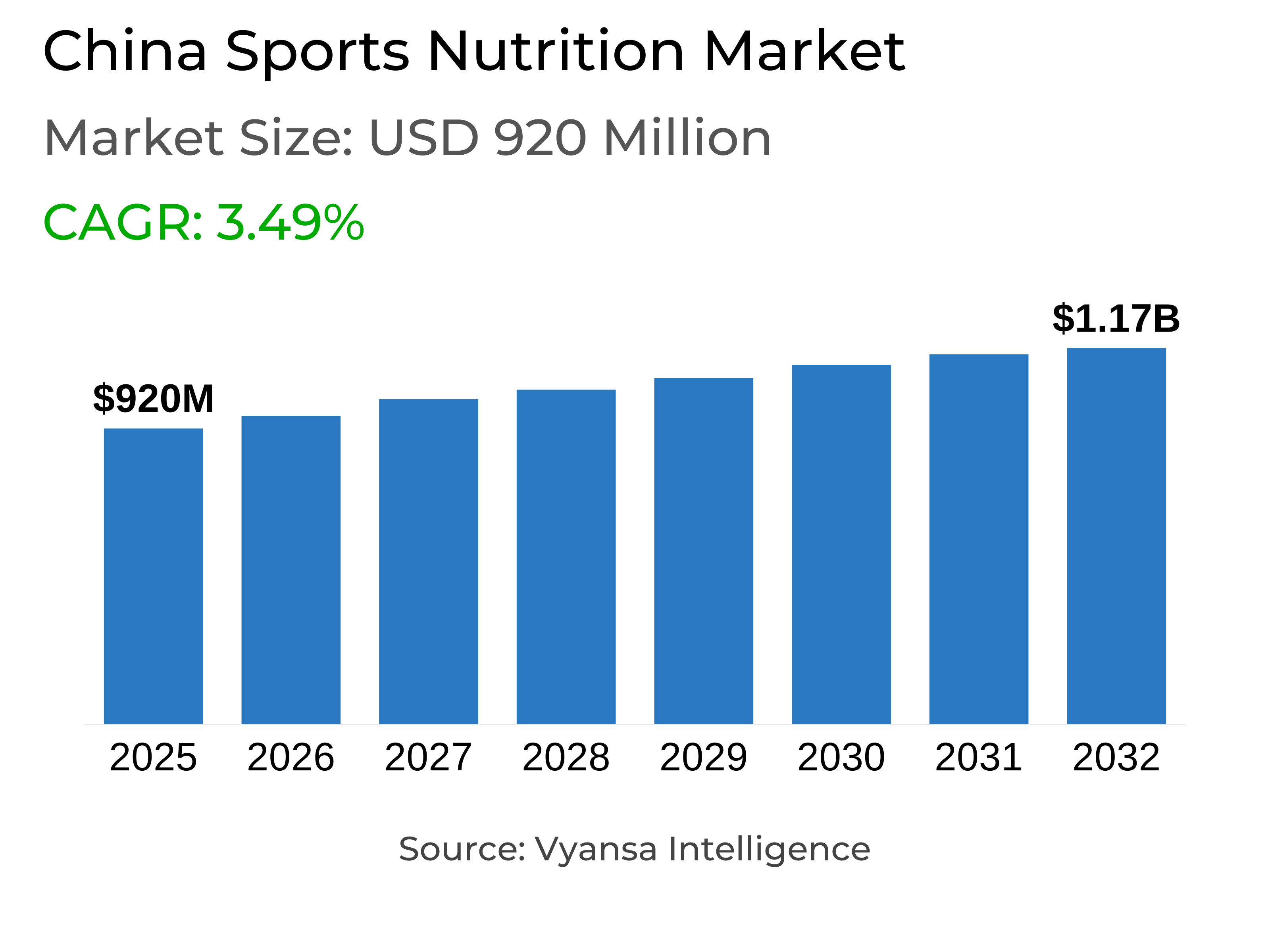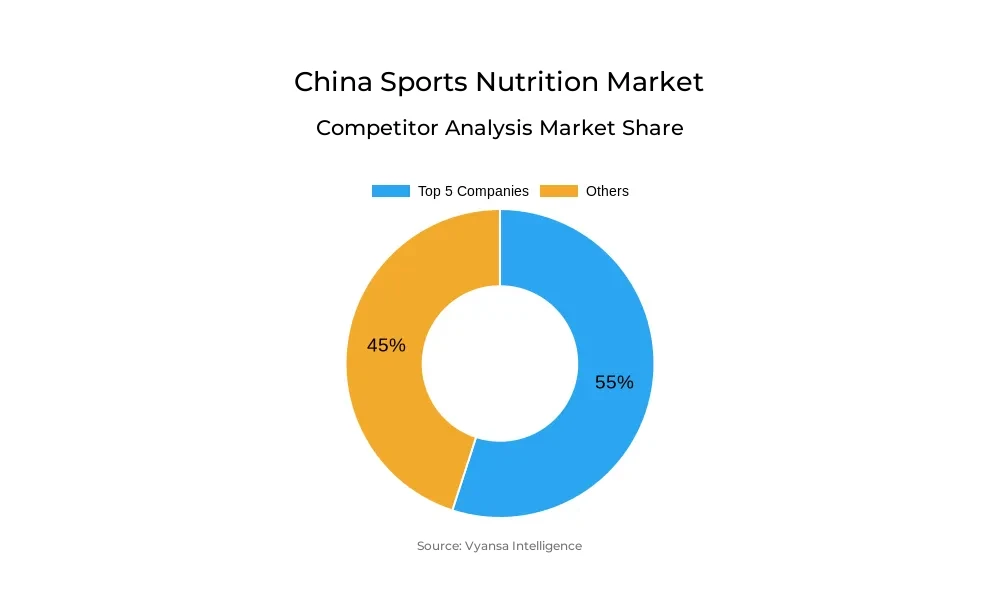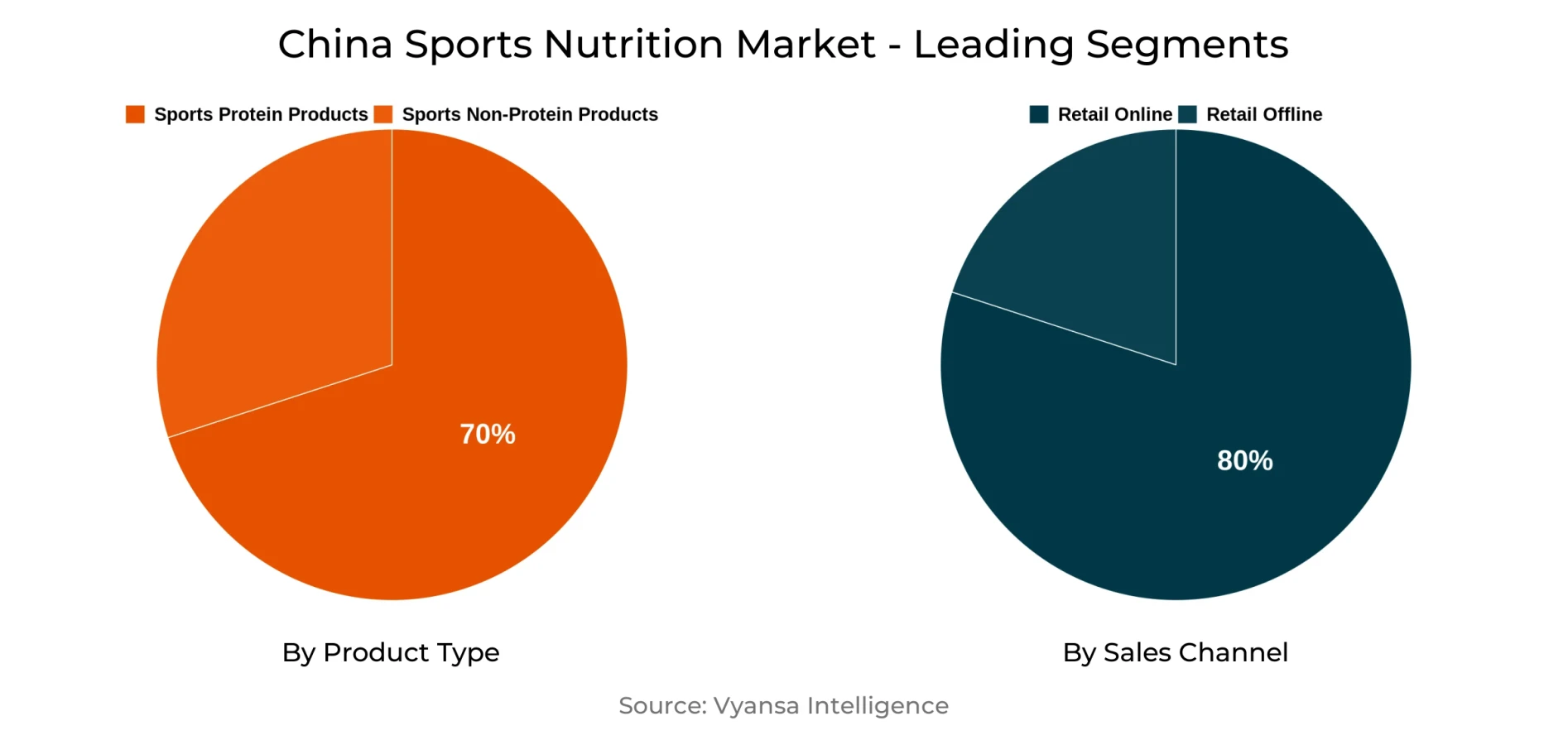China Sports Nutrition Market Report: Trends, Growth and Forecast (2026-2032)
Product Type (Sports Protein Products (Protein/Energy Bars, Sports Protein Powder, Sports Protein RTD), Sports Non-Protein Products), Sales Channel (Retail Offline, Retail Online), Ingredients (Vitamins and Minerals, Proteins and Amino Acids, Carbohydrates, Probiotics, Botanicals/Herbals, Others), Functionality (Energy, Muscle growth, Hydration, Weight Management, Others), End User (Bodybuilders, Athletes, Lifestyle Users)
- Food & Beverage
- Dec 2025
- VI0603
- 125
-




China Sports Nutrition Market Statistics and Insights, 2026
- Market Size Statistics
- Sports nutrition in china is estimated at USD 920 million.
- The market size is expected to grow to USD 1.17 billion by 2032.
- Market to register a cagr of around 3.49% during 2026-32.
- Product Type Shares
- Sports protein products grabbed market share of 70%.
- Competition
- More than 15 companies are actively engaged in producing sports nutrition in china.
- Top 5 companies acquired around 55% of the market share.
- By-health Co Ltd, Xiamen Huanyaxuan Trading Co, Shanghai Yi Fan International Trading Co, Xiwang Foodstuffs Co Ltd, Beijing Competitor Sports Technology JSC Ltd etc., are few of the top companies.
- Sales Channel
- Retail online grabbed 80% of the market.
China Sports Nutrition Market Outlook
Sports nutrition in China is anticipated at around $920 million in 2025 and is anticipated to grow at around $1.17 billion by 2032 with a CAGR of approximately 3.49% from 2026–2032. The growth is led by increasing end users who wants products that supports protein, health, and fitness. Products that enhance endurance, accelerate recovery, and enhance immunity are gaining popularity. End end users now seek items that accomplish more than mere nutrition, and this is prompting brands to create specialized solutions.
Sports protein products lead the market with approximately 70% of shares. These comprise protein/energy bars, sports protein powder, and ready-to-drink (RTD) drinks. Sports protein powder is the leading the segment and contributes to most of the growth in the market. RTD drinks and protein bars are gaining popularity due to their ease of use and convenience. Sports non-protein products are also growing, but they are significantly smaller compared to sports protein products.
Retail online is the main sales channel, holding around 80% of the market. Brands use online platforms, social media, and livestreaming to reach end users directly. Fitness and wellness influencers help raise awareness and boost sales. Retail offline stores also play a role by allowing end users to see and try products.
Ready to consume sports protein remains new but holds good growth potential. Such convenient beverages address the needs of time bound end users. New flavors, innovation, and improved awareness will drive their usage and define the future of China's sports protein.

China Sports Nutrition Market Growth DriverGrowing Demand for Functional Sports Nutrition
End users desire sports nutrition that supports protein, health, and fitness goals. Products that improve endurance, accelerate recovery, and enhance immunity are gaining popularity. Products such as branched-chain amino acids for recovery, L-carnitine for more energy during exercise, and creatine for strength are highly preferred. This shows that end users are looking for products that go beyond basic nutrition and help them achieve specific health and fitness goals.
This shift is driving the market towards more specialized products. End users want products that address specific needs, for example, quicker recovery from exercise or additional energy while exercising. Brands are responding by offering products that offers both performance advantages and general health support. Increased demand for these functional sports nutrition products is encouraging market development and shaping how new products are developed to meet the needs of active end users.
China Sports Nutrition Market ChallengeEnsuring food safety and product quality
One of the most important issues in the sports nutrition market is ensuring product quality and safety. In the past, there have been cases of unsafe practices such as use of industrial chemicals that have raised concern regarding the potential health risks. These incidents have affected end users confidence since end users rely on these products to help assist in their health and fitness objectives.
Concerns over the quality or safety of products will reduce adoption of new products and limits overall segment growth. With more end users becoming part of the market and more product variety coming in, ensuring trust and safety of sports nutrition products becomes more crucial. This issue continues to influence purchasing habits reflecting the critical need of maintaining uniform quality standards and strict monitoring to preserve long term segment growth.
China Sports Nutrition Market TrendGrowing demand for natural and organic ingredients
Sports nutrition is adopting natural and organic ingredients as end users value products that are free from artificial additives, hormones, and pesticide residues. End users are aware of the health risks caused by synthetic ingredients and are opting for cleaner, safer alternatives. This shift indicates that health, safety, and sustainability are gaining priority in purchasing decisions.
Businesses are reacting by making their products and formulations with natural sourced ingredients. Brands that emphasize clean and organic solutions can meet end user demand and maintain pace with health and wellness preferences. This change is transforming the sports nutrition industry, influencing product selection, innovation, and market expansion. Throughout the forecast period, the developement is likely to continue, supporting the production of healthier and more sustainable sports nutrition for end users.
China Sports Nutrition Market OpportunityReady-to-drink sports protein growth opportunity
Ready-to-drink sports protein drinks expected to see strong growth in the coming years. Standard protein powders, which often required to be mixed and are sold in large quantities, can be inconvenient for end users, particularly those that have regular fitness regimens. RTD protein products, with convenient packagings and high protein levels, will meet the emerging need for convenience and quick nutrition.
Additionally, as the RTD segment is currently in an emerging stage, it has huge potential to grow. With time, these drinks will capture market share from traditional protein powders by providing end users with more convenient and easier choice. With the ongoing product innovation, new flavors, and awareness of end users will increase adoption and shape the future of sports protein products.
China Sports Nutrition Market Segmentation Analysis

By Product Type
- Sports Protein Products
- Sports Non-Protein Products
Sports nutrition segment is dominated by sports protein products, which holds the biggest market share at around 70% of total segment. This segment includes protein/energy bars, sports protein powder, and ready-to-drink (RTD) protein drinks. Among these, sports protein powder leads as the dominant segment, consistently driving market growth. Sales of sports protein products have been rising as more end users focus on performance, recovery, and general fitness. Increased popularity of convenient forms, e.g., protein bars and ready-to-drink beverages, also supports the high demand for protein products in the market.
Sports non-protein products occupy a smaller share of the market, comprising products for endurance, hydration, and recovery. Although the segment is on the rise, it is still insignificant in comparison to sports protein products. Sports protein products continue to lead the market with emerging innovations such as RTD beverages and protein bars showing their dominance and attracting more end users.
By Sales Channel
- Retail Offline
- Retail Online
Retail online is the key distribution channel for sports nutrition, holding the largest value share of around 80%. Brands target retail online platforms to communicate directly with end users, engaging with end users via social media and livestreams. Fitness and wellness influencers endorse products, raise awareness, and drive sales. New brands, particularly for sports protein powder, are gaining popularity and facilitating the strong development of this channel. Convenience, variety, and direct engagement provided by retail online ensure that it is the most preffered option among many end users.
Retail offline remains significant, allowing end users to see and experience products in supermarkets, specialty nutrition stores, and gyms. These points of sale increase brand presence and complement retail online, ensuring end users have a variety of channels through which to access the products they desire.
Top Companies in China Sports Nutrition Market
The top companies operating in the market include By-health Co Ltd, Xiamen Huanyaxuan Trading Co, Shanghai Yi Fan International Trading Co, Xiwang Foodstuffs Co Ltd, Beijing Competitor Sports Technology JSC Ltd, Nutrend DS AS, Hut Group Ltd, The, Optimum Nutrition Inc, Smeal Biotechnology Co Ltd, Amway (China) Co Ltd, etc., are the top players operating in the china sports nutrition market.
Frequently Asked Questions
Related Report
1. Market Segmentation
1.1. Research Scope
1.2. Research Methodology
1.3. Definitions and Assumptions
2. Executive Summary
3. China Sports Nutrition Market Policies, Regulations, and Standards
4. China Sports Nutrition Market Dynamics
4.1. Growth Factors
4.2. Challenges
4.3. Trends
4.4. Opportunities
5. China Sports Nutrition Market Statistics, 2022-2032F
5.1. Market Size & Growth Outlook
5.1.1.By Revenues in US$ Million
5.2. Market Segmentation & Growth Outlook
5.2.1.By Product Type
5.2.1.1. Sports Protein Products- Market Insights and Forecast 2022-2032, USD Million
5.2.1.1.1. Protein/Energy Bars- Market Insights and Forecast 2022-2032, USD Million
5.2.1.1.2. Sports Protein Powder- Market Insights and Forecast 2022-2032, USD Million
5.2.1.1.3. Sports Protein RTD- Market Insights and Forecast 2022-2032, USD Million
5.2.1.2. Sports Non-Protein Products- Market Insights and Forecast 2022-2032, USD Million
5.2.2.By Sales Channel
5.2.2.1. Retail Offline- Market Insights and Forecast 2022-2032, USD Million
5.2.2.2. Retail Online- Market Insights and Forecast 2022-2032, USD Million
5.2.3.By Ingredients
5.2.3.1. Vitamins and Minerals- Market Insights and Forecast 2022-2032, USD Million
5.2.3.2. Proteins and Amino Acids- Market Insights and Forecast 2022-2032, USD Million
5.2.3.3. Carbohydrates- Market Insights and Forecast 2022-2032, USD Million
5.2.3.4. Probiotics- Market Insights and Forecast 2022-2032, USD Million
5.2.3.5. Botanicals/Herbals- Market Insights and Forecast 2022-2032, USD Million
5.2.3.6. Others- Market Insights and Forecast 2022-2032, USD Million
5.2.4.By Functionality
5.2.4.1. Energy- Market Insights and Forecast 2022-2032, USD Million
5.2.4.2. Muscle growth- Market Insights and Forecast 2022-2032, USD Million
5.2.4.3. Hydration- Market Insights and Forecast 2022-2032, USD Million
5.2.4.4. Weight Management- Market Insights and Forecast 2022-2032, USD Million
5.2.4.5. Others- Market Insights and Forecast 2022-2032, USD Million
5.2.5.By End User
5.2.5.1. Bodybuilders- Market Insights and Forecast 2022-2032, USD Million
5.2.5.2. Athletes- Market Insights and Forecast 2022-2032, USD Million
5.2.5.3. Lifestyle Users- Market Insights and Forecast 2022-2032, USD Million
5.2.6.By Competitors
5.2.6.1. Competition Characteristics
5.2.6.2. Market Share & Analysis
6. China Protein Products Sports Nutrition Market Statistics, 2022-2032F
6.1. Market Size & Growth Outlook
6.1.1.By Revenues in US$ Million
6.2. Market Segmentation & Growth Outlook
6.2.1.By Sales Channel- Market Insights and Forecast 2022-2032, USD Million
6.2.2.By Ingredients- Market Insights and Forecast 2022-2032, USD Million
6.2.3.By Functionality- Market Insights and Forecast 2022-2032, USD Million
6.2.4.By End User- Market Insights and Forecast 2022-2032, USD Million
7. China Non-Protein Products Sports Nutrition Market Statistics, 2022-2032F
7.1. Market Size & Growth Outlook
7.1.1.By Revenues in US$ Million
7.2. Market Segmentation & Growth Outlook
7.2.1.By Sales Channel- Market Insights and Forecast 2022-2032, USD Million
7.2.2.By Ingredients- Market Insights and Forecast 2022-2032, USD Million
7.2.3.By Functionality- Market Insights and Forecast 2022-2032, USD Million
7.2.4.By End User- Market Insights and Forecast 2022-2032, USD Million
8. Competitive Outlook
8.1. Company Profiles
8.1.1.Xiwang Foodstuffs Co Ltd
8.1.1.1. Business Description
8.1.1.2. Product Portfolio
8.1.1.3. Collaborations & Alliances
8.1.1.4. Recent Developments
8.1.1.5. Financial Details
8.1.1.6. Others
8.1.2.Beijing Competitor Sports Technology JSC Ltd
8.1.2.1. Business Description
8.1.2.2. Product Portfolio
8.1.2.3. Collaborations & Alliances
8.1.2.4. Recent Developments
8.1.2.5. Financial Details
8.1.2.6. Others
8.1.3.Nutrend DS as
8.1.3.1. Business Description
8.1.3.2. Product Portfolio
8.1.3.3. Collaborations & Alliances
8.1.3.4. Recent Developments
8.1.3.5. Financial Details
8.1.3.6. Others
8.1.4.Hut Group Ltd, The
8.1.4.1. Business Description
8.1.4.2. Product Portfolio
8.1.4.3. Collaborations & Alliances
8.1.4.4. Recent Developments
8.1.4.5. Financial Details
8.1.4.6. Others
8.1.5.Optimum Nutrition Inc
8.1.5.1. Business Description
8.1.5.2. Product Portfolio
8.1.5.3. Collaborations & Alliances
8.1.5.4. Recent Developments
8.1.5.5. Financial Details
8.1.5.6. Others
8.1.6.By-health Co Ltd
8.1.6.1. Business Description
8.1.6.2. Product Portfolio
8.1.6.3. Collaborations & Alliances
8.1.6.4. Recent Developments
8.1.6.5. Financial Details
8.1.6.6. Others
8.1.7.Xiamen Huanyaxuan Trading Co
8.1.7.1. Business Description
8.1.7.2. Product Portfolio
8.1.7.3. Collaborations & Alliances
8.1.7.4. Recent Developments
8.1.7.5. Financial Details
8.1.7.6. Others
8.1.8.Shanghai Yi Fan International Trading Co
8.1.8.1. Business Description
8.1.8.2. Product Portfolio
8.1.8.3. Collaborations & Alliances
8.1.8.4. Recent Developments
8.1.8.5. Financial Details
8.1.8.6. Others
8.1.9.Smeal Biotechnology Co Ltd
8.1.9.1. Business Description
8.1.9.2. Product Portfolio
8.1.9.3. Collaborations & Alliances
8.1.9.4. Recent Developments
8.1.9.5. Financial Details
8.1.9.6. Others
8.1.10. Amway (China) Co Ltd
8.1.10.1. Business Description
8.1.10.2. Product Portfolio
8.1.10.3. Collaborations & Alliances
8.1.10.4. Recent Developments
8.1.10.5. Financial Details
8.1.10.6. Others
9. Disclaimer
| Segment | Sub-Segment |
|---|---|
| By Product Type |
|
| By Sales Channel |
|
| By Ingredients |
|
| By Functionality |
|
| By End User |
|
Research Methodology
This study followed a structured approach comprising four key phases to assess the size and scope of the electro-oxidation market. The process began with thorough secondary research to collect data on the target market, related markets, and broader industry context. These findings, along with preliminary assumptions and estimates, were then validated through extensive primary research involving industry experts from across the value chain. To calculate the overall market size, both top-down and bottom-up methodologies were employed. Finally, market segmentation and data triangulation techniques were applied to refine and validate segment-level estimations.
Secondary Research
The secondary research phase involved gathering data from a wide range of credible and published sources. This step helped in identifying industry trends, defining market segmentation, and understanding the market landscape and value chain.
Sources consulted during this phase included:
- Company annual reports, investor presentations, and press releases
- Industry white papers and certified publications
- Trade directories and market-recognized databases
- Articles from authoritative authors and reputable journals
- Gold and silver standard websites
Secondary research was critical in mapping out the industry's value chain and monetary flow, identifying key market segments, understanding regional variations, and tracking significant industry developments.
Other key sources:
- Financial disclosures
- Industry associations and trade bodies
- News outlets and business magazines
- Academic journals and research studies
- Paid industry databases
Primary Research
To validate secondary data and gain deeper market insights, primary research was conducted with key stakeholders across both the supply and demand sides of the market.
On the demand side, participants included decision-makers and influencers from end-user industries—such as CIOs, CTOs, and CSOs—who provided first-hand perspectives on market needs, product usage, and future expectations.
On the supply side, interviews were conducted with manufacturers, industry associations, and institutional participants to gather insights into current offerings, product pipelines, and market challenges.
Primary interviews provided critical inputs such as:
- Market size and revenue data
- Product and service breakdowns
- Market forecasts
- Regional and application-specific trends
Stakeholders consulted included:
- Leading OEM and solution providers
- Channel and distribution partners
- End users across various applications
- Independent consultants and industry specialists
Market Size Estimation and Data Triangulation
- Identifying Key Market Participants (Secondary Research)
- Goal: To identify the major players or companies in the target market. This typically involves using publicly available data sources such as industry reports, market research publications, and financial statements of companies.
- Tools: Reports from firms like Gartner, Forrester, Euromonitor, Statista, IBISWorld, and others. Public financial statements, news articles, and press releases from top market players.
- Extracting Earnings of Key Market Participants
- Goal: To estimate the earnings generated from the product or service being analyzed. This step helps in understanding the revenue potential of each market player in a specific geography.
- Methods: Earnings data can be gathered from:
- Publicly available financial reports (for listed companies).
- Interviews and primary data sources from professionals, such as Directors, VPs, SVPs, etc. This is especially useful for understanding more nuanced, internal data that isn't publicly disclosed.
- Annual reports and investor presentations of key players.
- Data Collation and Development of a Relevant Data Model
- Goal: To collate inputs from both primary and secondary sources into a structured, data-driven model for market estimation. This model will incorporate key market KPIs and any independent variables relevant to the market.
- Key KPIs: These could include:
- Market size, growth rate, and demand drivers.
- Industry-specific metrics like market share, average revenue per customer (ARPC), or average deal size.
- External variables, such as economic growth rates, inflation rates, or commodity prices, that could affect the market.
- Data Modeling: Based on this data, the market forecasts are developed for the next 5 years. A combination of trend analysis, scenario modeling, and statistical regression might be used to generate projections.
- Scenario Analysis
- Goal: To test different assumptions and validate how sensitive the market is to changes in key variables (e.g., market demand, regulatory changes, technological disruptions).
- Types of Scenarios:
- Base Case: Based on current assumptions and historical data.
- Best-Case Scenario: Assuming favorable market conditions, regulatory environments, and technological advancements.
- Worst-Case Scenario: Accounting for adverse factors, such as economic downturns, stricter regulations, or unexpected disruptions.
Partnering With Industry Leaders to Drive Growth
Our mission is to deliver intelligence that matters. By combining data, analysis, and industry expertise, we enable organizations to make smarter, faster, and more impactful decisions. Whether it’s a Fortune 500 company or a high-growth startup, businesses trust us to provide clarity in an ever-evolving marketplace.






